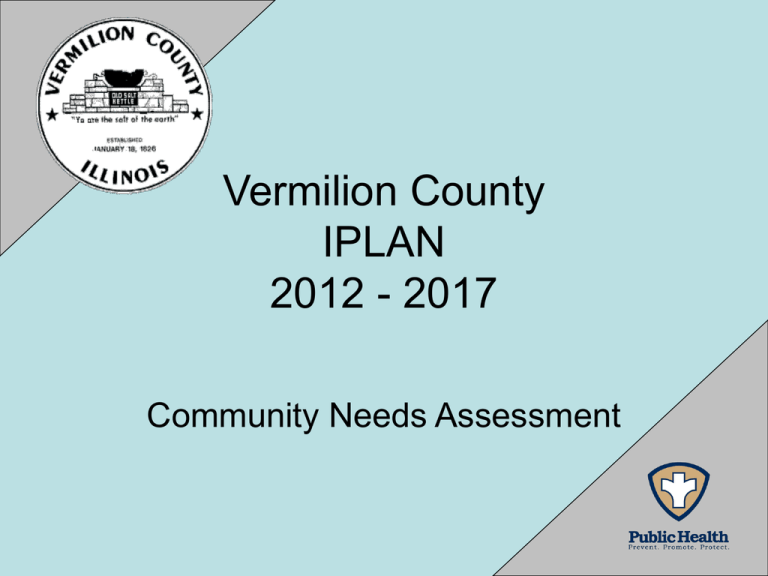
Vermilion County
IPLAN
2012 - 2017
Community Needs Assessment
2012-2017 IPLAN
PLEASE MAKE SURE YOU HAVE SIGNED
IN ON THE SIGN-IN SHEET!
THANK YOU
IPLAN 2012-2017
The Illinois Project for Local Assessment of Needs
(IPLAN) is a Community health assessment
and planning process that is conducted every
five years by local health jurisdictions in Illinois.
The essential elements of IPLAN are:
• An organizational capacity assessment;
• A community health needs assessment; and
• A community health plan, focusing on a
minimum of three priority health problems.
IPLAN Team
• Shirley Hicks, BS, CPHA
– VCHD Public Health Administrator
• Jenny Trimmell, BSN, PHN
– VCHD Director of Community Health
Services
• Melissa Rome, MBA, CERC, CHES
– VCHD Emergency Planning and Response
Coordinator
• Dr. Krista Jones
– UIC School of Nursing Instructor
– IPLAN Consultant
Health Problem
Health problem: a situation or condition of
people which is considered undesirable, is
likely to exist in the future, and is
measured as death, disease, or disability.
Source: Assessment Protocol for Excellence in Public Health
Vermilion County Demographic
Changes 2000 vs 2010
2000
2010
Population
83919
81625
Median Age
38
39.8
65 and older
16.0%
16.3%
White (%)
85.8 %
82.5%
Black (%)
10.6%
13.0%
Hispanic
3.0%
4.2%
Housing Units
36349
36318
Owner Occupied
71.0%
69.9%
Renter Occupied
28.3%
30.1%
Vacant Units
8.1%
10.1%
Population age
25+
66.0%
67.5%
Population age
25-44
27.2%
23.7%
• 2.7% overall decrease in
population since 2000
– Decrease in white population/
increases in black & hispanic
populations from 2000 to 2010
• Increase in renter occupied/
decrease in owner occupied
housing.
• Vacant housing units increased
by 2%
• 24.9% of population (age 18-24)
had less than a H.S. diploma
• Median Household Income:
$37,167 (2009 data)
• Persons below poverty level
21.7% (2009 data)
Poverty
25
20
15
10
5
0
Poverty Rate
Kn
ox
La
Sa
lle
M
ac
Ve on
rm
ilio
n
Ad
Ch am
am s
pa
Ka ign
nk
ak
ee
Child Poverty Rate
no
is
Illi
Rate of Poverty
Poverty Rates for Selected Counties
County
•Overall Poverty Rate: US Census Bureau 2006-2010
•Child Poverty Rate: County Health Rankings 2011
Poverty
•
•
•
•
Vermilion County child abuse and
neglect rate rose from 14.8 (per 1,000)
in 2003 to a rate of 20.1 (per 1,000) in
2010, however have seen a decrease
in the last 2 years. The Illinois rate
was 7.5 and 8.3 respectively.
Vermilion County children receiving
medical assistance (KidCare and
Medicaid) rose 29.0% from 9,990
children (2005) to 12,892 children
(2011).
There were 5,483 children under the
age of 5 (2010 census data) in
Vermilion County; 36.7% of these
children live in households below
poverty rates.
16.4% of children ages 5-17 live below
poverty (2010 data).
Source: Kids Count 2012
US Census
• Between 2000 and
2010 (children 5-17
who are in poverty in
schools)
– District #118 – 21.78 to
35.03 = 60.87% increase
– Catlin – 2.83 to 11.39 =
302.92% increase
– Armstrong HS – 14.46 to
10.75 = 25.63% decrease
– Hoopeston 13.48 to 31.55
= 134% increase
Source: U.S. Census via News Gazette
Child Poverty Rates
Source: Voices for Illinois Children
2012 Report
County Rankings 2011
Rank Health Outcomes
Rank
(Mortality/ Morbidity)
(Health Behaviors,
Clinical Care,
& Economic
Physical
Social
Factors,
Environment)
98
Vermilion
Health Factors
96
Out of 102 Counties
Vermilion
County Rankings 2011
Social & Economic Factors
HS Graduation Rate
Some College
Unemployment
Children in Poverty
Rank: 98 / 102
VC
Illinois
75%
80%
49%
11.5%
23%
64%
10.1%
17%
25%
21%
42%
31%
(per 100,000 population)
Inadequate Social Support
(per 100,000 population)
Single Parent Households
Violent Crime Rate
(per 100,000 population)
700
550
County Rankings 2011
Clinical Care
Uninsured Adults (under age 65)
Primary Care Providers
Preventable Hosp. Stays
Diabetic Screening
Rank: 35 / 102
VC
Illinois
12%
17%
1,298:1
101
80%
778:1
83
80%
64%
63%
(Medicare enrollees that receive HbA1c screening)
Mammography Screening
(Medicare enrollees)
County Rankings 2011
Physical Environment
Air Pollution-particulate
matter days (annual # days)
Air pollution-ozone days
Rank: 38 / 102
VC
Illinois
0
3
0
4
38%
53%
(annual # days)
Access to Healthy foods
(health food outlets: grocery stores & produces stands/farmers
markets)
Access to recreational
facilities
(per 100,000 population)
9
10
Leading Causes of Death
in Vermilion County
•
Leading Causes of death (2006 data) in
Vermilion County are as follows:
1.
2.
3.
4.
5.
6.
7.
Diseases of the Heart
Cancer
Chronic Lower Respiratory Disease
Cerebrovascular Diseases (Stroke)
Accidents
Diabetes Mellitus
Nephritis, etc. (Kidney Disease)
(IPLAN Data System Report 2006, app. idph.state.il.us)
Leading Causes of Death
in Vermilion County (#1)
• Diseases of the heart remains the leading
cause of death in Vermilion County.
– In 2008 24% of all deaths were due to diseases of the
heart (226 deaths). The majority of those deaths were
due to Coronary Heart Disease specifically.
– There has been a gradual decline in deaths due to
diseases of the heart since 2003 with an overall
decrease of 7%
– According to the BRFSS 2007-09, Vermilion County
had a 2.8% decrease in smokers but a 2.9% increase
in those who report being obese and a 12.3%
decrease in those report they meet the recommended
amount of physical activity
RISK FACTORS THAT MAY CONTRIBUTE TO HEART DISEASE
BRFSS Comparison Data
Vermilion County
2004-06
2007-09
% changed
Smoker
30.60%
27.7%
2.8% ↓
Told have high blood
pressure
30.4%
33.8%
3.4% ↑
Take meds for blood
pressure
87.8%
77.3%
10.5% ↓
Told cholesterol high
35.8%
43.2%
7.4% ↑
Normal weight/ underweight
35.75%
32.5%
3.2% ↓
Overweight
37.2%
37.5%
.3% ↑
Obese
27.1%
30.0%
2.9% ↑
Meets recommended
physical activity
46.8%
43.1%
12.3% ↓
Insufficient activity
37.3%
41.8%
4.5% ↑
Inactive
15.9%
15.2%
.7% ↓
0-2 servings fruit/veggies/day
58.6%
64.5%
5.9% ↑
3-4 servings fruit/veggies/day
26.9%
28.8%
1.9% ↑
5+ servings fruit/veggies/day
14.5%
7.2%
7.3% ↓
Leading Causes of Death
in Vermilion County (#2)
• Cancer (all types) is the 2nd leading cause
of death in Vermilion County
– V.C. rate for all cancers is 522.1 compared to
the state rate of 490.4 (HP 2020 target is
160.6/100,000)
– There were 224 deaths in 2006 due to all
cancers; 70 of those deaths were due to Lung
Cancer specifically
– In gender specific data for highest number of
deaths from cancer were prostate cancer for
men and breast cancer for women
OBESITY
• Obesity and physical inactivity has been linked
to a range of chronic diseases including
diabetes and hypertension.
– 20 years ago 12.1% of Illinois residents were obese;
currently (2008-2010) 27.7% are obese (F as in Fat Report, www.healthamericans.org;
RWJF)
– 20 years ago 5.2% of Illinois residents had diabetes;
currently (2008-2010) 8.4% have diabetes
– 20 years ago 21.9% of Illinois residents had
hypertension; currently (2008-2010) 27.5% have
hypertension
• 30.0% of Vermilion County adult residents
report fitting the criteria for obesity (2007-09 BRFSS)
OBESITY & CHILDREN
• Almost 1/3 of U.S. children and adolescents
between the ages of 2 and 19 are overweight or
obese
• Children who are obese are more than twice as
likely to die before the age of 55 as children
whose BMI is in the normal range.
• Children who are obese after the age of 6 are
50% more likely to be obese adults.
• Those who did not graduate high school have
the highest rates of obesity. (32.8% obesity rate)
– Vermilion County has a 75% graduation rate
(F as in Fat 2011 Report; www.healthyamericans.org, RWJF)
Childhood Obesity in Illinois
(F as in Fat 2011 Report; www.healthyamericans.org, RWJF)
• Illinois ranked 4th highest in the U.S. for obesity in children ages
10-17 yrs old Illinois tied with Louisiana for 4th, Mississippi, Georgia
and Kentucky were 1-3 respectively
• Obesity is correlated with income
– Households that make less than $15,000 have a 33.8% obesity rate
– Households making between $15,000 & $25,000; obesity rate is 31.8%
– Households making between $25,000 & $35,000; obesity rate is 29.7%
– Households making between $35,000 & $50,000; obesity rate is
29.5%
Median Income for V.C. residents $37,167 (2009 data)
•
• In Vermilion County 16.4% of children ages 5-17 live below
poverty (2010census data)
– There were 5483 children under the age of 5 (2010 census data) in Vermilion County;
36.7% of these children live in households below poverty rates
Teen Pregnancy
Vermilion County
Teen Births
Live Births
Mother
< 20
% of births
to teens
VC
% of births
to teens
Illinois
Infant
mortality
cases
Infant
mortality
rate
2004
1079
177
16.4%
9.9%
6
**
2005
1112
180
16.2%
9.7%
11
**
2006
1176
166
14.1%
10.0%
7
**
2007
1117
151
13.5%
10.1%
8
**
2008
1094
164
15.0%
10.0%
9
**
2009
1100
172
15.6%
9.6%
Not avail
**
•The 13.5% teen birth rate in 2007 was the lowest % of teen births since we
began keeping records in 1970; this was still above State rate of 10.1%.
•VC students who have had sexual intercourse sometime in their life reached the
highest percent since data was first collected in 2002 (ISBE 2010 data).
The 2010 number (55.7%) represents an increase of 4.5% from 2002
and an even greater increase of 6.5% from 2008.
TEEN BIRTHS
Health Concerns
• Approximately 400,000 teens aged 5-19 yrs give birth
every year in the U.S.
• The U.S. teen birth rate remains the highest in the
developed world
• Teen mothers are more likely to experience negative
social outcomes, including school dropout.
• Infants of teen mothers are more likely to be low birth
weight & have lower academic achievement
• Daughters of teen mothers are more likely to become
teen mothers themselves.
(CDC: MMWR Jan 20, 2012 / 61(02);25-29)
TEEN BIRTHS
Additional Statistics
Data from the Pregnancy Risk Assessment Monitoring System (PRAMS)
collected in 19 states (Illinois participates in PRAMS), during 2004-2008, for
teens aged 15-19, who became pregnant unintentionally & gave birth to a
live infant indicated:
• 50.1% reported doing nothing to prevent pregnancy
• Of these teens, 31.4% thought they could not get
pregnant at the time
• 23.6% did not use contraception because their partner
did not want to use it
• 22.1% did not mind getting pregnant
(CDC: MMWR Jan 20, 2012 / 61(02);25-29)
Reported Chlamydia Cases in
Vermilion County 2007-2011
Source IDPH STD SECTION
Provider
Type
2007/cases
total
VCHD
separate
2008/cases
total
VCHD
separate
2009/cases
total
VCHD
separate
2010/cases
total
VCHD
separate
2011/cases
total
Health Dept
STD & FP
207
STD
136
FP
71
224
STD
140
FP
84
191
STD
86
FP
105
99
STD
91
FP
8
Private
Physician
174
167
137
225
294
Hospital
84
65
52
70
175
Aunt
Martha’s
1
0
1
25
71
Adult
Corrections
13
17
19
12
17
JDC
4
14
8
4
15
438
587
13
Top 6 Providers listed; other Provider categories not included on this chart***
TOTALS
491
496
413
STD DATA: Chlamydia
Reported Chlamydia Cases in Vermilion County
350
Reported Cases
300
250
Health Department
Private Physician
Hospital
Aunt Martha's
200
150
100
50
0
2007
2008
2009
Year
2010
2011
STD TRENDS:
Chlamydia
• Chlamydia case reports have been steadily increasing
over the past 20 years in the U.S. In 2010, 1.3 million
Chlamydia cases were reported in the U.S. While some
of the increase is due to expanded screening efforts, a
majority of infections go undiagnosed. (per: CDC 2010 STD
Surveillance)
• In Illinois:
(Per 2009 IDPH STD Section Data; Ill HIV/AIDS/STD Monthly
Surveillance Update)
– Majority of Chlamydia cases are seen in the age ranges of 15-19
(36.3%) & 20-24 (36.0%).
Ages 25-29 (18.5%)
– More females than male
– By race: Highest in African Americans, White, Unknown
– By Ethnicity: Highest in Non-hispanic (73.9%); Hispanic (10.3%)
STD TRENDS:
Chlamydia con’t
• In 2010, Vermilion County was #10 in top
10 highest counties for Chlamydia. (Jackson,
Peoria, Alexander, St. Clair, Pope, Macon, Pulaski,
Champaign, Sangamon were 1-9 respectively)
Reported Gonorrhea in Vermilion County
By Provider Type
2007-2011
Provider Type
2007/cases
total
VCHD
separate
2008/cases
total
VCHD
separate
2009/cases
total
VCHD
separate
2010/cases
total
VCHD
separate
2011/cases
total
VCHD
separate
Health Dept
STD & FP
122
STD
107
FP
15
91
STD
71
FP
20
67
STD
48
FP
19
18
STD
17
FP
1
3
STD
3
FP
0
Private
Physician
61
40
43
29
51
Hospital
100
69
37
22
83
Aunt
Martha’s
0
0
0
4
18
Adult
Corrections
13
8
2
8
4
JDC
1
6
5
1
3
82
162
Top 6 Providers listed; other Provider categories not included on this chart***
TOTALS
300
218
158
STD DATA: Gonorrhea
Reported Gonorrhea Cases in
Vermilion County
Cases
150
100
50
0
2007 2008 2009 2010 2011
Years
VCHD
Private MD
Hospital
Aunt Martha's
STD TRENDS:
Gonorrhea
• Gonorrhea rates are at historically low levels in the U.S. Cases
increased slightly from 2009 to 2010 (300,000 cases in 2010 in U.S.)
In the last 10 years (2000-2010) the Gonorrhea rate decreased from
128.7/100,000 to 100.8/100,000. per CDC 2010 STD Surveillance
• CDC surveillance systems indicate that Gonorrhea may become
resistant to the only available treatment option.
• In the U.S., African Americans are most affected by Gonorrhea.
(Black rate 512.2; Hispanic rate 63.2; White rate 26.0 (per 100,000)
• Gonorrhea in Illinois (per IDPH STD section report 1/30/2012) (*Note: Illinois reporting is “cases” vs CDC “rates” above)
– 61.0% of all positive cases were in ages 10-29; with highest prevalence
in age group 15-19 yr old, 10.6%
– is highest in prevalence in Black population, 8.9%; followed by Other
2.3%, then White 2.2%.
– is prevalent in Non-Hispanic population 6.9%; Hispanic 2.3%
– More males, 7.8% have Gonorrhea than females, 4.3%
• Vermilion County ranked 15th in top counties with STD’s in 2010.
STD TRENDS:
Syphilis
• The overall Syphilis rate decreased for the first time in a
decade in the U.S. and is down 1.6% since 2009 per CDC
2010 STD Surveillance
• Early Syphilis Data for Illinois (Per IDPH STD Section 2009; Ill
HIV/AIDS/STD Monthly Surveillance Update) :
– Highest in 20-49 yr old population: 20-24 yr olds (17.9%); 2529 (17.2%); 30-34 (13.2%) 35-39 (12.2%); 40-44 (12.1%) 45-49
(12.0%)
– By gender: More males than females
– By Race: African Americans (55.9%);
Unknown (20.1%); White (19.0%)
– By Ethnicity: More Non-Hispanic (84.1%) than Hispanic (13.4%)
• In Vermilion County: 0 cases of Early Syphilis in 2008; 6
cases in 2009; 2 cases in 2010 (as of Oct 2010)
STD Trends:
HIV/AIDS
Per: Ill. HIV/AIDS/STD Monthly Surveillance
Update (October 2011) for Vermilion
County
• 6 cases of HIV diagnosed
• 40 cumulative cases of HIV diagnosed since
2005*; total of 52 people living with HIV in VC
• 1 case of AIDS diagnosed 25 cumulative cases
of AIDS diagnosed since 2005*; total of 60
people living with AIDS in VC
*2005—named reporting began in Illinois
STD Trends:
HIV/AIDS
• In Illinois HIV/AIDS*:
– Highest in Black population (51.5%); White
(26.0%; Hispanic 15.5%)
– Age at diagnosis; highest in 20-39 yr ages
– Mode of exposure MSM (46.0%); Other
(17.7%); Heterosexual (13.2%);
Undetermined (12.9%); IDU (7.1%)
*Per: Ill. HIV/AIDS/STD Monthly Surveillance Update October 2011
(Not full year data)
VIOLENCE
Vermilion County
Data
Year/2008
% change
from
2007 to 2008
% change from
2004 to 2008
Total Crime
Index
Offense
4167
0.7%
(4136)
14.0%
(3646)
Murder
2
-66.7%
(6)
-75.0%
(8)
Criminal Sexual
Assault
54
-39.3%
(89)
-32.5%
(80)
Robbery
97
-32.2%
(143)
32.9%
(73)
Aggravated
Assault/
Battery
349
-7.7%
(378)
-15.2%
(412)
Burglary
1040
6.4%
(977)
24.6%
(835)
Theft
2460
5.6%
(2330)
16.7%
(2121)
Motor Vehicle
Theft
133
-27.7%
(184)
30.4%
(102)
Arson
32
10.3%
(29)
113.0%
(15)
Total Crime Index for
Vermilion County increased
0.7% from 2007 to 2008; but
increased 14.0% from 2004 to
2008
Robbery, Burglary, Theft,
Motor Vehicle Theft and Arson
all increased from 2004 to
2008
Murder, Criminal Sexual
Assault and Aggravated
Assault/Battery all decreased
from 2004 to 2008
In 2008 there were 389 drug
arrests (-13.4% decrease from
2007--449 arrests)
Per Illinois State Police Crime Report 2007/2008
VIOLENCE and V.C.YOUTH
(I
Sing the Body Electric 2010 data)
• Nearly 41.0% of Vermilion County teens have been the
target of bullying on school property during the past 12
months
• 34.7% of students said someone had spread a rumor
about them online, in a chat room, through a social
networking site in emails or through text messaging
• 47.7% of VC students report being sent a threatening or
aggressive e-mail, instant message or text message
• 7.0% of VC youth stayed home from school because
they felt unsafe at school or on the way to or home from
school
• 11.1% of VC youth report being threatened or injured by
someone with a weapon at school in the past year
VIOLENCE and V.C. YOUTH
(I
Sing the Body Electric 2010 data) con’t
• At least once, females in 9th grade (27.6% and males in
11th grade (27.5%) report the highest percentage of
those saying that someone had stolen or deliberately
damaged their property while at school
• One in 5 female (19.1%) and one in 5 male (20.5%)
students report being hit, slapped or physically hurt by a
boyfriend or girlfriend. This is an increase in two year’s
time of 32.6% of females and 19.2% of males being
abused by their partners
• In their lifetime, 17.1% of 2010 VC high school females
and 8.7% of high school males report being “physically
forced to have sex when they did not want to”
Health Risk Concerns of Youth in
Vermilion County
I Sing the Body Electric Data 2010: 3,164 out of 4,106
(77.1%) students in grades 9-12 in our local schools
participated in survey & ranked their top concerns as:
• #1 Drinking & Driving, Alcohol Use (unchanged from 2008 survey)
• #2 Sexual Behaviors (AIDS, STDs, teen pregnancy)
(unchanged from 2008 survey)
• #3 Drug Use (has been in top 3 or 4 since 2002)
• #4 Body Image (weight) Eating Disorders, Use of
Steroids (has been in top 3 or 4 since 2002)
• #5 Carrying Weapons, Threats, Bullying, Physical
Fighting (ranked #8 in 2002; moved to #5 in 2010)
2007-2012 IPLAN Data
• Reduce the incidence of premature deaths (<age 65)
due to diseases of the heart in Vermilion County.
– Met this overall priority. Deaths from heart disease decreased
from 259 in 2006 to 226 in 2008. (2009-2011 data not yet available)
• There was a reduction in the percentage of VC adults who smoke
• There was an increase in the percentage of adults who report being
at risk for health problems related to being overweight
• Percent of adults reporting cholesterol increased but unknown
whether number increase due to more people being tested or more
people having higher cholesterol**
• Percent of adults with high blood pressure increased but unknown
whether due to increased testing or more people having higher
blood pressures.**
• Unknown whether adults under 65 had their blood sugar checked**
**VCHD had planned to enhance testing opportunities to adults under
65 but program was terminated.
2007-2012 IPLAN Data
• Reduce the percentage of birth to teens in
Vermilion County
– Partially met: Teen births decreased in 2006 (14.1%)
and in 2007 (13.5%). 13.5% lowest percentage since
recording keeping began in 1970. But teen births
then climbed back to 15.6% in 2009.
– Did not meet goal to reduce the percentage of youths
reporting sexual intercourse before age 17. (ISBE 2010
data shows 55.7% of youth reporting having had sexual intercourse; a
4.5% increase from 2002 and 6.5% increase from 2008)
2007-2012 IPLAN Data
• Reduce violent and abusive behaviors in Vermilion
County
Met?
• From 2007 to 2008
• Total Crime Index Offense increased by 0.7%
• Increase in Burglary, Theft, and Arson
• Decrease in Murder, Criminal Sexual Assault, Robbery
– From 2004 to 2008
• Total Crime Index Offense increased by 14.0%
• Increase in Robbery, Burglary, Theft, Motor Vehicle Theft and Arson
• Decrease in Murder, Criminal Sexual Assault, Aggravated
Assault/Battery
– We (community) did expand and enhance community awareness on this
issue: Youth Violence Prevention Coalition (2008) (BB/BS); Illinois
Family Violence Prevention Coalition—Vermilion County; Illinois Health
Cares Project (15 community partners)--Violence Video-2008; Violence
Prevention:6 Best practices for healthcare providers)
2011-12 Community Survey Data
• Who filled out the survey?
– Over 1,000 surveys have been completed so far. We
will conclude taking surveys at the end of March.
– Nursing students from U of I, Lakeview, and DACC
passed out surveys to the residents of Vermilion
County.
– Age Range for the surveys are 15-90 years of age.
– Gender for the surveys was 71% female, 28% male.
– Some of the locations were McDonalds, Town Center,
St. James Food Pantry, DACC, Parish Nurse
Churches, Vermilion House, Doctor’s Offices, YFRC,
Fair Oaks, YMCA, etc.
2011-12 Community Survey Data
• Who filled out the survey?
– About 7% of the surveys were the Northern areas
including Hoopeston, Rankin, Rossville, Alvin,
Armstrong, and Bismarck.
– About 8 % of the surveys were from the Western areas
including Catlin, Oakwood, Sidell, Fithian, and
Fairmount.
– About 66% of the surveys were from the County Seat,
Danville.
– About 15% of the surveys were from the Southern
areas including Ridgefarm, Indianola, Westville, Tilton,
and Georgetown.
– About 2% of the surveys were from areas outside
Vermilion County including Milford, Urbana, champaign,
Ogden, Rantoul, and Frankfurt, IN, Covington, IN,
Kingman, IN, and Stateline, IN.
Demographics of Survey Data
Quality of Life Statements
Healthy Community
Personal Health
Quality of Environment
The Importance on
Community Issues
“Your” Top 3 Health
Concerns
Top 3 Community
Health Problems
Top 3 Risky Behaviors
Comments from Survey Data
Comments made in survey that were not part of the survey.
Section 1: Quality of Life Statements
•
Health care system: No health in Westville
•
Health care system. Needs to be level 1 trauma
•
Economic Opportunity – Not enough well paying jobs
•
Faith based – Do Not Participate
Section 2: Community and Environmental Issues
•
No lights at Home Gardens (Rt1 between Lete Ln and Lyons Road) TURN THE LIGHTS BACK
ON!!!
•
Water impure
•
Crime Patrols/Block Watches – lacking
•
Crime Patrols/Block Watches – not working – break ins
•
Quality of Life – Too many killing (sic)
•
Mass Transportation – need to make the card assessable (sic)
•
Adequate street lighting - sidewalks
Other Comments
•
Need a Health Department
•
We need the Health Department for STD’s to open back up (2)
•
Need more programs at the Health Department
Inconsistencies:
•
Some questions on hand written surveys had to be skipped for analysis due to multiple answers
for a one answer question.
•
A few people also put down more than 3 for their health problems/risky behaviors.
2012-2017 IPLAN
Thank you!
Questions????
Additional Data and
Powerpoint can be
found on
www.vchd.org
2012-2017 IPLAN
• Shirley Hicks
– 217-431-2662 ext 267
– shicks@vchd.org
• Jenny Trimmell
– 217-431-2662 ext. 229
– jtrimmell@vchd.org
• Melissa Rome
– 217-431-2662 ext. 246
– mrome@vchd.org
• Dr. Krista Jones
– kjones29@illinois.edu





